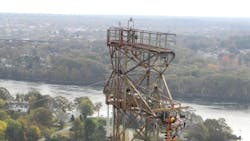PSNH Saves Time and Money with Live Line Maintenance of Piscatqua River 345-kV Span
Following a detailed aerial inspection by Haverfield Aviation, Inc. (Gettysburg, PA), Public Service of New Hampshire (PSNH) determined there was a need for maintenance on a stretch of line across the Piscataqua River from the Portsmouth, NH crossing to the Maine side. PSNH concluded that although the lines, installed in the early 1970s, were in good shape, age and wear of numerous components had created possible safety hazards. Dubbed the Schiller Project, the plan required the replacement of insulators on two 350-ft towers, and vibration dampers on 1750 ft of line energized with 345 kV.
Completing the project through conventional method, using ground based crews climbing the towers, would be time consuming and labor intensive. Factoring in the additional complexities involved with de-energizing the line and supplying alternative sources of electricity for customers during the work resulted in a project completion estimate of anywhere from one - four months, depending on factors such as weather. However, a proposal from Haverfield, utilizing the company’s Live Line Maintenance (LLM) product and their Specialized Services Team (SST), determined that the project could be completed much more quickly, and at a fraction of the cost, using aerial services.
“Haverfield crews were in here doing live line work. The benefit that brings is that we don’t have to send crews up there to do the mechanical work which would be very, very tedious and labor intense by going up there with ladders and ropes,” said Gary Booth, project leader for PSNH. “The helicopter brings the people up to the structure, in situation. They’re right there doing the work very closely. They cut the work down tremendously.”
The intricacies of the double circuit line, single wire, with a double insulator string posed a number of challenges. A specialized aerial spacer cart, and a uniquely engineered winch to run through sheave blocks, were fabricated specifically for the project. A helicopter was used to “long-line” a two-man crew and the specialized equipment to the towers where the insulators were replaced. The spacer cart was used to trolley along the line to replace the dampeners. Originally estimated to take eight - 10 days, the project was completed in five days at a cost savings of approximately 35% compared to conventional methods.
